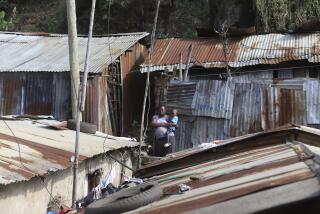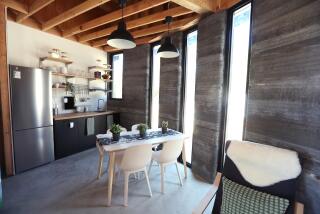Earthen-Block Home for Third World Shows That Small Is Beautiful
LONDON — Its walls are made of earthen blocks, it is cheap to build--and it could reduce homelessness and deforestation in the Third World.
The house costs just $170 to assemble and is intended as a model home for developing countries, affordable and environmentally friendly.
“People in Africa have aspirations too,” said Frank Almond of the British charity Intermediate Technology, which has been promoting the home. “This is an example of how a house can be built cheaply using only local resources and materials.”
A model of the house attracted public and media attention at London’s recent Ideal Home Exhibition, where it nestled incongruously among deluxe bathroom suites and fake antique windows.
The walls are slabs of earth stabilized with cement to prevent crumbling and the roof is made of durable, fiber-reinforced tiles that are quick and easy to make.
Inside, a fuel-saving stove consumes 40% less firewood than the traditional three-stone fire.
A house built with bricks requires the energy equivalent of 20 trees--to fire the bricks--but with the stabilized earthen blocks only half a tree is needed.
Small companies or individuals can produce the tiles and blocks with minimal equipment and training.
The home is not a complete do-it-yourself package that can be bought ready for assembly, Almond said. It is meant to show how locally produced materials, used appropriately, can meet the housing needs of poor communities.
Intermediate Technology’s founder was Fritz Schumacher, who wrote the 1970s best seller “Small Is Beautiful: Economics as if people mattered.” The book has inspired a generation of environmentalists and “green” economists with its credo of self-reliance and sustainable growth.
Intermediate Technology was the name Schumacher gave to a system of production based on communal ownership and small working units that used local materials and resources --small-scale technology with a human face.
“Man is small, and therefore small is beautiful,” he wrote. “To go for giantism is to go for self-destruction.”
Schumacher’s attitude toward Third World development was based on the old adage that it is better to give a man a fishing rod than a fish. Teach him to fish, or even better to make his own fishing tackle, and he becomes self-reliant for life, no longer dependent on grudging handouts from rich neighbors.
Schumacher, who died in 1977, accused politicians, bureaucrats and big business of sacrificing long-term goals for short-term profits and called for a new attitude to economics based on attention to the needs of people.
The United Nations estimates that about 2 billion people will be homeless by the year 2001. In the last decade, shantytowns and squatter camps have increased rapidly throughout the developing world with an estimated 400 million people migrating to the cities in search of work.
“It is important to see squatter settlements as part of the solution on which to build rather than just an unsightly problem to be bulldozed,” said Intermediate Technology spokesman Steve Bonnist.
Intermediate Technology, which marks its 25th anniversary this year, operates projects in seven countries: Peru, Sudan, Zimbabwe, Kenya, Bangladesh, Sri Lanka and Nepal.
These projects include the introduction of fuel-saving stoves in Sri Lanka, a micro-hydro project in Nepal and the application of food processing techniques in Peru.
And what would Schumacher have made of the house being displayed at commercial fairs?
“He would certainly be glad to see how much his ideas on technology and development have moved into the mainstream and are available to the general public,” Bonnist said.
“But he also liked to poke fun at our commercialism and he would be amused to see the 100-pound house at the ideal home exhibition standing next to vacuum cleaners that sell for 10 times as much.”
More to Read
Sign up for Essential California
The most important California stories and recommendations in your inbox every morning.
You may occasionally receive promotional content from the Los Angeles Times.






